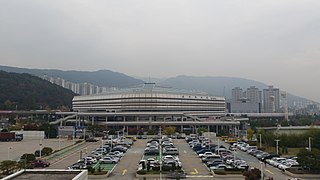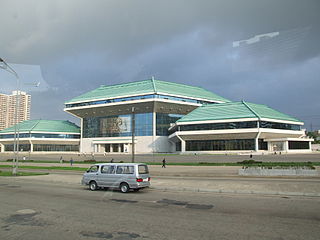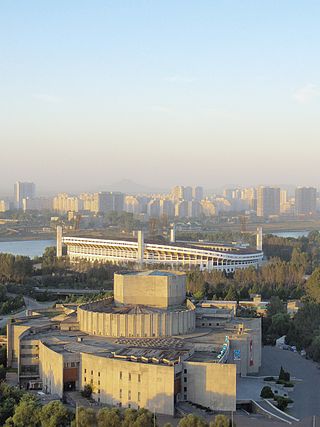
The Chongnyon Hotel is a hotel located in the Mangyongdae District of Pyongyang, the capital city of North Korea. It was opened on 1 May 1989 and is situated on the junction of Chongchun Street and Kwangbok (Liberation) Street.

The Arch of Triumph is a triumphal arch in Pyongyang, North Korea. It was built to commemorate the Korean resistance to Japan from 1925 to 1945. It is the second tallest triumphal arch in the world, after Monumento a la Revolución in Mexico, standing 60 m (197 ft) high and 50 m (164 ft) wide.

Moranbong or Moran Hill forms a park located in central Pyongyang, the capital of North Korea. Its 312-foot (95 m) summit is the location of the Pyongyang TV Tower.

The Kumsusan Palace of the Sun, formerly the Kumsusan Memorial Palace (금수산기념궁전), is a building near the northeast corner of the city of Pyongyang that serves as the mausoleum for Kim Il Sung, the founder of North Korea, and for his son Kim Jong Il, both posthumously designated as Eternal leaders of North Korea.

Sŏsan Stadium (Korean: 서산축구경기장) is a football stadium in Pyongyang, North Korea. It is currently used mostly for football matches. The stadium holds 25,000 people, and was built by the North Korean army in 1988 for the 13th World Festival of Youth and Students. It lies next to Ryanggang Hotel which was completed around the same time in 1989.
Ŏp'a station is a railway station in Ŏp'a-rodongjagu, P'yŏngwŏn County, South P'yŏngan Province, North Korea. It is on located on the P'yŏngŭi line of the Korean State Railway.
Ch'ŏnju-sa (Korean: 천주사) is a Korean Buddhist temple located on the southern slope of Yaksan mountain, in Yongbyon, North Pyongan province, North Korea. It is listed as National Treasure #46 in that country. Founded in 1684 during the mid-Joseon dynasty, the temple today retains its main prayer hall, known as Pogwang Hall (普光殿); the Chonju Pavilion (天柱樓), once known as one of the six most scenic spots in Yongbyon; and several lesser outbuildings, including storage rooms, and dormitories. Many buildings still feature delicate original paintings in a well-preserved state.

The Grand People's Study House is the central library located in the North Korean capital, Pyongyang. The building is situated on Kim Il Sung Square by the banks of the Taedong River.

The Mangyongdae Children's Palace in Pyongyang is a public facility managed by Korean Youth Corps in North Korea where pioneer members can engage in extra-curricular activities, such as learning music, foreign languages, computing skills and sports. It was established on 2 May 1989 and it is situated in Kwangbok (Liberation) Street, in the north of Mangyongdae-guyok. It is the largest of the palaces in North Korea dedicated to children's after-school activities. In front of the Children's Palace there are a grand sculpture group and two enormous fountains, rising 90 and 100 metres.

The Rungra People's Pleasure Ground is an amusement park located in Rungra Island, Pyongyang, North Korea. It was opened in 2012 in a ceremony with Kim Jong Un and his wife Ri Sol-ju. It has a dolphinarium, swimming pool, arcade, mini golf course, fun fair, and courts for tennis, badminton, and volleyball. The park has been expanded many times over the years and now has its own trolley transportation system.

The Pyongyang Grand Theatre is a theatre located in North Korea. It was opened in 1960.

The Moranbong Theatre is a theatre located in Moranbong, Pyongyang, North Korea. It was opened in 1946 and renovated in 2006.

The Pyongyang Circus is a multi-function building located in Pyongyang, North Korea. It was completed in 1989.

The International Cinema Hall (평양국제영화회관) is a cinema located in North Korea. It holds the Pyongyang International Film Festival.

The Korean Central History Museum is a museum located in Pyongyang, North Korea. The museum is located at the north end of Kim Il-sung Square. It contains displays on Korean history from primitive society to the modern age.

The Korean Art Gallery (조선미술박물관) is an art museum situated on the south side of Kim Il-sung Square in Chung-guyok, Pyongyang, North Korea, which opened in 1948.
The Korean Folklore Museum (조선민속박물관) is a museum in North Korea, located north of the Korean Central History Museum next to the Taedong Gate in Pyongyang. It was opened in February 1956. The museum has seven rooms comprising 1,800 square meters of space, with 2,100 exhibits.
The Anhak Palace (Korean: 안학궁) was the royal residence of the Goguryeo Kingdom after the capital was moved to Pyongyang from Gungnae. Originally built in 427 AD, the palace is located in the Taesong District of Pyongyang, North Korea, at the foot of Mount Taesong.

The April 25 House of Culture is a theatre located in Pyongyang, North Korea. It was built in 1974–1975 to provide a venue for military education, and was originally called the February 8 House of Culture. It is located on Pipha Street in the Moranbong District of Pyongyang. The classically colonnaded building is considered one of the best examples of 1970s socialist monumentality in North Korea, the other being the visually similar Mansudae Art Theatre.
The People's Palace of Culture is a palace and theater located in Pyongyang, North Korea. Construction for the building finished in January 1974 and was opened to the public in April 1974. South Korean President Kim Dae-jung was given a welcome ceremony at the People's Palace of Culture during the 2000 inter-Korean summit.
















